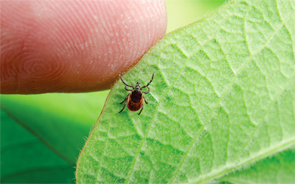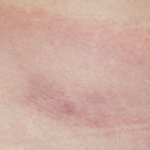
Lyme disease is transmitted to humans via the bite of infected blacklegged ticks.
Image Credit: PHOTO FUN/shutterstock.com
She held out her hands. Not all of the joints were affected. The small joints adjacent to the fingernails were uniformly normal, while the middle joints of the fingers and knuckles were tender and swollen. She flinched when I flexed and extended the wrists. Sliding my examining hand up the forearm, a firm nodule the size of a marble was palpable at the bony prominence of both elbows.
Rheumatologists often arrive at a definitive diagnosis in a decidedly low-tech fashion. Patiently teasing out a complete history narrows the possible explanation for the patient’s symptoms. The distribution of tender or swollen joints also helps. Lyme arthritis, for example, affects a single knee in 80% of cases. Swelling of all three joints in a single finger or toe (giving the appearance of a sausage digit) is characteristic of psoriatic arthritis or ankylosing spondylitis, while the arthritis of Crohn’s disease—an immune system disorder affecting the bowel—primarily affects the large joints of the lower extremities, the knees and ankles.
Rheumatoid arthritis (RA) typically is symmetric and, early on, usually involves the small joints of the hands and feet. The growths at Lynn’s elbows sealed my opinion; they were almost certainly rheumatoid nodules.
The Diagnosis
Already a wife and mother, Lynn P. was now, and into the foreseeable future, an RA patient. The difficult work of adjusting to a chronic, uncertain and, sometimes, crippling lifelong disease lay before her.
Finishing my exam, I reviewed the labs Lynn’s internist had ordered. Levels of inflammation, a C-reactive protein (CRP) and erythrocyte sedimentation rate (ESR) were normal and her rheumatoid factor was absent. But that’s not unusual; laboratory tests are often normal in early RA, even in the presence of florid joint swelling. In the first six months of the disease, rheumatoid factors are positive in only 50% of cases. Even adding a newly developed, more specific test, an antibody to anti-cyclic citrullinated peptides (CCP), brings this number up only to 80%.
Ultimately, Lynn has RA, because—and this sounds oddly pompous—because I say so.
But at today’s initial visit, I hedged. Although I was confident that Lynn P. had RA, I was not 100% certain, and there was something about her demeanor—she’d volunteered almost nothing besides simple yes and no answers to my questions—that made me hesitate. I realized I had no sense of who she was beyond the bare bones of the questionnaire she’d filled out in the waiting room.



